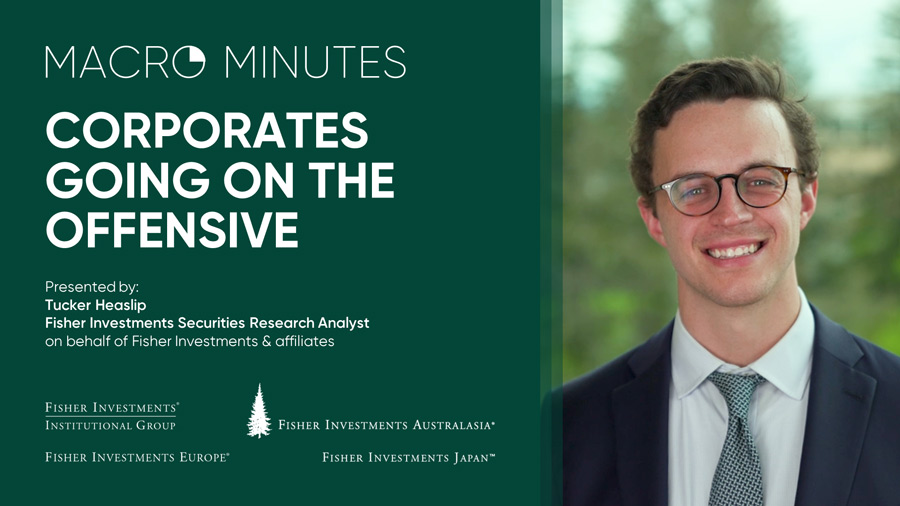Personal Wealth Management / Economics
No, April’s ‘Goldilocks’ Jobs Data Don’t Shed Light on Fed Cuts
A friendly reminder: Jobs don’t reveal what the Fed will do next.
Was America’s jobs porridge just right? Some say so after April’s hiring slowdown and tiny uptick in the unemployment rate led many to speculate a cooler jobs market made rate cuts more likely—particularly against the backdrop of last week’s Fed meeting. This reverses many folks’ viewpoints from mere days earlier, if not hours. And in the process, the swinging outlooks highlight a simple point: Trying to forecast Fed moves is an exercise in futility—investors should tune out such speculation.
On the jobs front, April US nonfarm payrolls rose 175,000 in April, lower than expectations for 235,000.[i] Notably, government hiring slowed considerably (up 8,000 in April compared to the average of 55,000 over the past 12 months).[ii] The unemployment rate also ticked up to 3.9% from March’s 3.8% while wage growth slowed (from 4.1% y/y to April’s 3.9%).[iii]
To many, this relatively weaker report was a clear positive. Since the Fed wants to see slower hiring, this report supposedly suggests it is getting what it wants. That allegedly increases the likelihood of a Fed rate cut sooner than later, which headlines celebrated as super bullish.
But all this comes just after many of the same folks claimed relatively quick-rising labor costs in a separate series suggested “higher for longer” rates. The narrative—and associated expectations—are volatile. Look to one gauge of 30-day fed funds futures pricing data to see this.
Fed funds futures tracked by the CME FedWatch Tool suggest rates are likely to be lower at some point this year. Most don’t expect any change at the June 12 Fed meeting, but after Friday’s release, the probability of a 25-basis point (bp, or 0.25 percentage point) cut at July’s get-together ticked up to 34%.[iv] That figure rises to around 50% by September’s meeting and over 90% by yearend.[v]
But hold on! At 2024’s start, traders pegged a 0% probability of a 5.25% – 5.50% Fed target rate range (where it is now) at May’s meeting.[vi] Instead, they thought the most likely target rate was 4.75% – 5.0%—amounting to a reduction of 50 bps from the beginning of the year.[vii] The closer we got to May, though, the probability of no change rose—from 27% in February to 90% by mid-March.[viii] Note, too, just over the last couple of weeks, the futures-implied probability of rate cuts has gyrated wildly up and down.
Now, these probabilities also don’t really tell you anything about the reality of what the Fed may do. This is a market-oriented tool, which are generally better than things like surveys, in our view. But it isn’t gauging what the cabal of people who set rates think. It is what futures traders think they think, and it is—quite obviously—subject to volatility. This speaks to a point we have made here often: Monetary policy isn’t predictable. Central bankers’ actions aren’t a market function.
Take labor data. Headlines presume Jerome Powell and friends are exchanging high-fives because their “tighter” monetary policy is slowing (but not derailing) growth. But is that conclusion truly assured? One Fed governor may believe April’s employment figures shout “mission accomplished,” but another may want to see more data (and June’s jobs report) before committing to cuts. What if another Fed policymaker interpreted the government hiring slowdown as the central cause for the weaker headline number—and decided to dismiss the report, since government employment says nothing of how America’s private sector, the economy’s growth engine, fared? Or what if policymakers decide the report on labor costs from earlier last week is more significant? Or other, non-employment-related data? We could go on—and that is a huge problem for those trying to divine when cuts come.
Beyond not being able to forecast central bankers’ decisions, monetary policy is only one economic input. It isn’t all powerful, which you would think the last 18 months of pundits’ expecting recession tied to tightening—only for the economy to generally accelerate—would prove. Could rate cuts help some areas? Sure, it is possible. But don’t overrate the effect. GDP has grown in a variety of fed-funds rate environments—including the present! So the impact on growth is overstated. Stocks have shown the exact same thing since October 2022, with the early days far preceding material talk of rate cuts. Heck, the Fed was still hiking then. The evidence we need cuts today is flimsy.
[i] Source: FactSet, as of 5/6/2024.
[ii] Source: BLS, as of 5/3/2024.
[iii] Ibid.
[iv] Source: CME FedWatch Tool, as of 5/3/2024.
[v] Ibid.
[vi] Ibid.
[vii] Ibid.
[viii] Ibid.
If you would like to contact the editors responsible for this article, please message MarketMinder directly.
*The content contained in this article represents only the opinions and viewpoints of the Fisher Investments editorial staff.
Get a weekly roundup of our market insights.
Sign up for our weekly e-mail newsletter.

See Our Investment Guides
The world of investing can seem like a giant maze. Fisher Investments has developed several informational and educational guides tackling a variety of investing topics.








